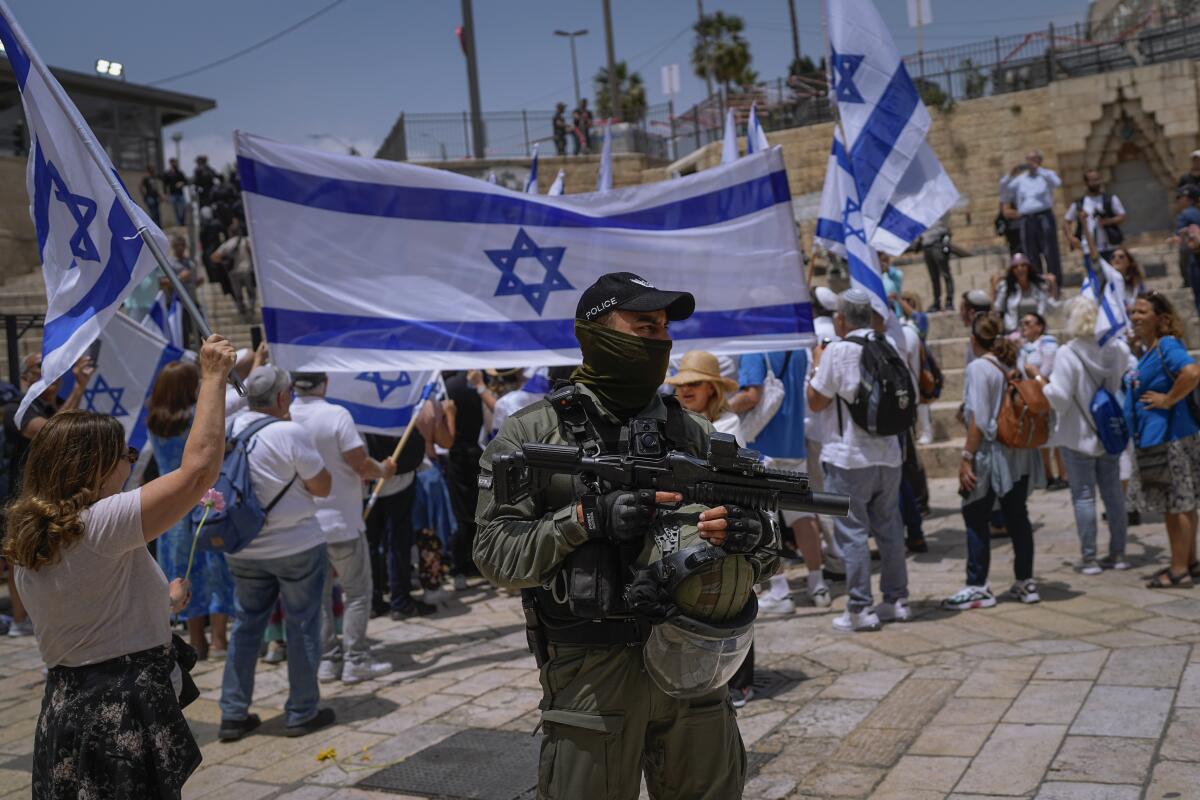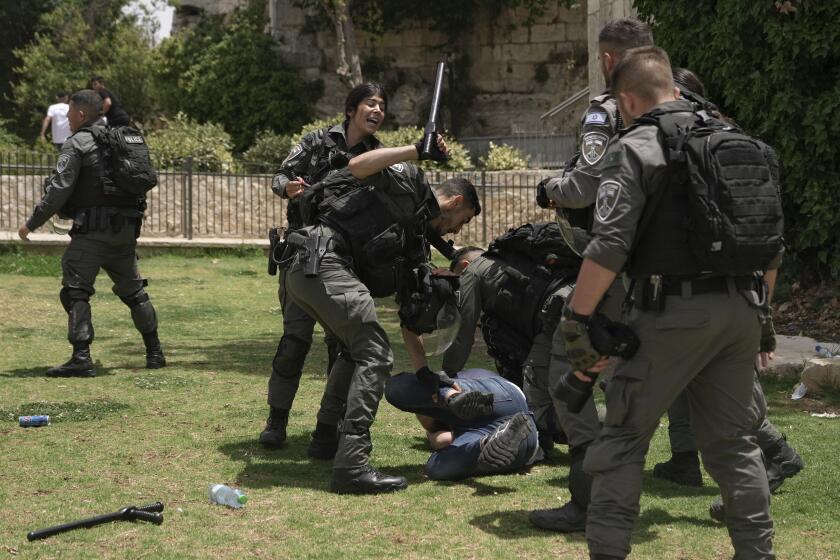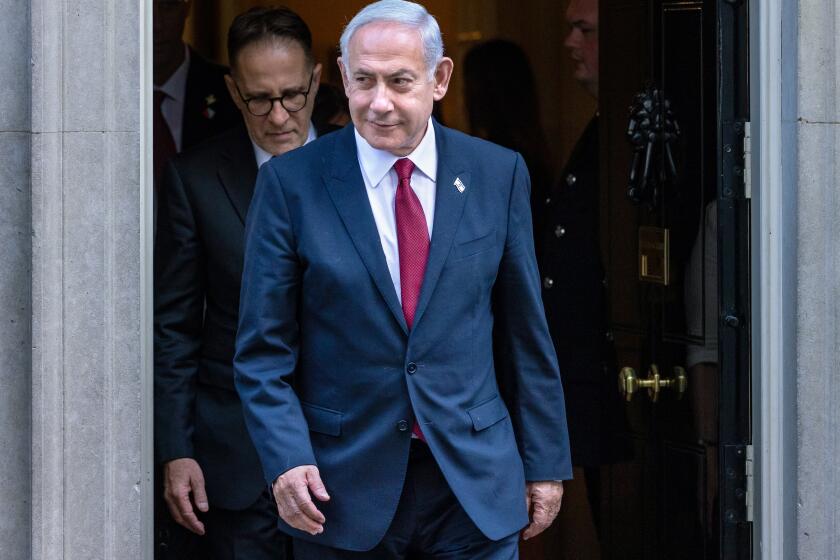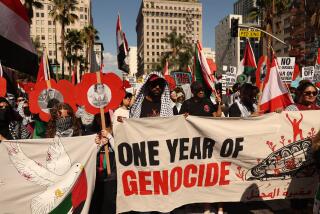Israeli crowds chant racist slogans, taunt Palestinians during Jerusalem march

- Share via
JERUSALEM — Thousands of Jewish nationalists, some of them chanting “Death to Arabs” and other racist slogans, paraded Thursday through the main Palestinian thoroughfare of Jerusalem’s Old City, in an annual display that caused new friction between Jews and Palestinians in the tense city.
The marchers, who were overwhelmingly male Orthodox teens and young men, were celebrating Jerusalem Day, which marks Israel’s capture of the Old City 56 years ago. The Palestinians see the event as a provocation. Two years ago, the parade helped fuel an 11-day war between Israel and Hamas militants in the Gaza Strip.
Throughout the afternoon, dozens of groups hoisting blue-and-white Israeli flags streamed through Damascus Gate — the entry to the area’s Muslim Quarter — as they made their way across the Old City to the Western Wall, the holiest site where Jews can pray. The area is normally bustling on Thursday afternoons with Palestinians doing their errands ahead of the weekend.
Naftali Bennett has defended an annual march that celebrated Israel’s takeover of east Jerusalem and was marked by violence and anti-Palestinian racism.
The boisterous crowds danced and chanted Jewish religious songs outside Damascus Gate as scores of Israeli police stood guard. In several cases, groups chanted slogans such as “Death to Arabs,” “Muhammad is dead” and “May your village burn” as they stared at Palestinian onlookers. Some of the youths wore clothing identifying themselves as members of Lehava, a far-right Jewish supremacist group that opposes assimilation or romantic relationships between Jews and Palestinians.
Israeli police, who had said that violence and incitement would not be tolerated, kept the sides apart but did little to stop the chants. Palestinian businesses were either shuttered or empty, and marchers occasionally threw water bottles at nearby journalists, eliciting cheers from the crowd. Police said two people were arrested for throwing objects.
Several lawmakers in Israel’s new far-right governing coalition, including National Security Minister Itamar Ben-Gvir, joined the procession. Under heavy police guard, Ben-Gvir waved to the crowd as he made his way through Damascus Gate and then high-fived security forces inside. Ben-Gvir, who oversees the nation’s police force, is a former far-right activist and hard-line West Bank settler who has been convicted of incitement and support for a Jewish terrorist group.
While there were repeated scuffles and confrontations between Jews and Palestinians, the parade appeared to take place without serious violence. By nightfall, the massive crowd had converged in the plaza in front of the Western Wall.
An Israeli minister says there’s ‘no such thing’ as a Palestinian people even as Israel and the Palestinian Authority try to reduce tensions.
Jerusalem Day is meant to celebrate Israel’s capture of East Jerusalem, including the Old City and its holy sites, in the 1967 Middle East War. Israel considers all of Jerusalem to be its capital, but its annexation of East Jerusalem is not internationally recognized. The Palestinians seek East Jerusalem as the capital of a future state.
The event has been a source of friction over the years, and over 2,500 police were deployed for this year’s parade, with hundreds more stationed around the city.
Israel decided to allow the marchers to take the traditional route through Damascus Gate, instead of an alternate path circumventing the Muslim Quarter, despite an uptick in Israeli-Palestinian violence over the last year and heavy fighting last week between Israel and Palestinian militants in Gaza.
Ahead of the march, Gaza’s ruling militant group Hamas called on Palestinians to oppose the event.
On Thursday, dozens of Palestinian protesters gathered along the perimeter fence separating Gaza and Israel, raising Palestinian flags, burning tires and Israeli flags, and throwing stones toward the heavily guarded frontier.
Breaking News
Get breaking news, investigations, analysis and more signature journalism from the Los Angeles Times in your inbox.
You may occasionally receive promotional content from the Los Angeles Times.
Israeli troops fired tear gas and rubber bullets toward protesters, injuring three people, according to local media reports. There was no immediate comment from Gaza’s health authorities.
The protest ended without further violence that could have threatened a flare-up. It comes days after an Egyptian-brokered cease-fire ended five days of fighting between Israel and the smaller, more radical militant group Islamic Jihad in Gaza.
Nabil abu Rudaineh, spokesman for the Palestinian Authority president in the occupied West Bank, said allowing the march to wend its way through Palestinian areas of the Old City “will only lead to a rise in tension and could lead to an explosion.”
In a test before the parade, nearly 1,300 Jews visited Jerusalem’s most sensitive holy site earlier Thursday, about half the number last year, according to Beyadenu, an activist group that promotes Jewish visits to the site. Police were seen escorting groups of Jewish visitors walking through the compound and five members of the far-right coalition government also arrived at the site, the group said.
If the Netanyahu government falls apart, it is unclear who would fill the void or what new unrest could be ignited.
Neighboring Jordan, which serves as a custodian of the Jerusalem shrine, condemned the Jewish visits there and the trajectory of the march. Egypt, the first Arab country to make peace with Israel, and the United Arab Emirates, which established ties with Israel as part of the 2020 Abraham Accords, also condemned the visits to the site.
The hilltop compound is known to Jews as the Temple Mount, home to the ancient Jewish temples, and is the holiest site in Judaism. Palestinians revere it as the Noble Sanctuary, and it is home to Al Aqsa Mosque, the third-holiest site in Islam.
Under long-standing agreements, Jews are permitted to visit the site but not pray there. But an increase in such visits, along with scenes of some Jews quietly praying, has raised concerns among Palestinians that Israel is trying to alter the status quo — a charge Israel denies.
The competing claims to the site lie at the heart of the Israeli-Palestinian conflict and often spill over into violence, including a 2021 war between Israel and Hamas.
AP correspondents Fares Akram in Gaza City and Jack Jeffery in Cairo contributed to this report.
More to Read
Sign up for Essential California
The most important California stories and recommendations in your inbox every morning.
You may occasionally receive promotional content from the Los Angeles Times.













